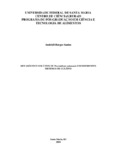| dc.creator | Santos, Andriéli Borges | |
| dc.date.accessioned | 2021-05-07T19:46:45Z | |
| dc.date.available | 2021-05-07T19:46:45Z | |
| dc.date.issued | 2018-12-13 | |
| dc.identifier.uri | http://repositorio.ufsm.br/handle/1/20820 | |
| dc.description.abstract | Microalgae are a potential source of biomolecules of commercial interest due to their
diversified metabolic profile capable of synthesizing different organic classes of
compounds. The Phormidium autumnale is a cyanobacteria with growth ability in the three
main cultivation types: photoautotrophic, mixotrophic and heterotrophic. The aim of this
thesis was to investigate the profile of microalgal volatile organic compounds (VOCs)
under different culture conditions. The results obtained in the experiments allowed the
identification of 53 volatile organic compounds in total. In the heterotrophic cultivation
using starch as carbon source, a total of 22 VOCs was identified and quantified, the least
productive experiment being in the volatile fraction; already the heterotrophic culture
supplemented with sucrose obtained a greater production with 34 identified compounds.
Different chemical classes (aldehydes, alcohols, ketones and hydrocarbons) were found in
the experiments, the majority were aldehydes and alcohols. The significant presence of
these chemical classes shows that the applicability of these volatile compounds produced
is extensive. Research on the profile of volatile organic compounds is required to
investigate microalgae in order to identify potential candidates for use in a new generation
of formulations of food, feed, biofuels, pharmaceuticals and raw material for the fine
chemicals industry. In parallel to this research, the review “Microalgal Biorefineries for
Bioenergy Production: Can We Move from Concept to Industrial Reality? which was
published in the Journal BioEnergy Research and is attached to this document. | eng |
| dc.language | por | por |
| dc.publisher | Universidade Federal de Santa Maria | por |
| dc.rights | Attribution-NonCommercial-NoDerivatives 4.0 International | * |
| dc.rights.uri | http://creativecommons.org/licenses/by-nc-nd/4.0/ | * |
| dc.subject | Cianobactéria | por |
| dc.subject | Microalga | por |
| dc.subject | Compostos orgânicos voláteis | por |
| dc.subject | GC-MS | por |
| dc.subject | Biotransformação | por |
| dc.subject | Cyanobacteria | eng |
| dc.subject | Microalgae | eng |
| dc.subject | Volatile organic compounds | eng |
| dc.subject | Biotransformation | eng |
| dc.title | Metabólitos voláteis de Phormidium autumnale em diferentes sistemas de cultivo | por |
| dc.title.alternative | Phormidium autumnale volatile metabolites in different cultivation systems | eng |
| dc.type | Tese | por |
| dc.description.resumo | As microalgas são uma potencial fonte de biomoléculas de interesse comercial devido ao seu
perfil metabólico diversificado capaz de sintetizar diferentes classes de compostos orgânicos.
O gênero Phormidium autumnale é uma cianobactéria com habilidade de crescimento nos 3
principais tipos de cultivo: fotoautotrófico, mixotrófico e heterotrófico. Em face disso, a tese
teve por objetivo investigar o perfil de compostos orgânicos voláteis (COVs) microalgais em
diferentes condições de cultivo. Os resultados obtidos nos experimentos, possibilitaram a
identificação de 53 compostos orgânicos voláteis no total. No cultivo heterotrófico utilizando
amido como fonte de carbono, foram identificados e quantificados um total de 22 COVs, sendo
o experimento menos produtivo na fração volátil; já o cultivo heterotrófico suplementado com
sacarose obteve uma maior produção com 34 compostos identificados. Diferentes classes
químicas (aldeídos, álcoois, cetonas e hidrocarbonetos) foram encontradas nos experimentos,
os majoritários foram os aldeídos e álcoois. A presença significativa dessas classes químicas
mostra que a aplicabilidade desses compostos voláteis produzidos é extensa. Pesquisas sobre o
perfil de compostos orgânicos voláteis são necessárias para investigar as microalgas, a fim de
identificar os candidatos potenciais para uso em uma nova geração de formulações de
alimentos, rações, biocombustíveis, produtos farmacêuticos e matéria-prima para a indústria de
química fina. Em paralelo à esta pesquisa, foi produzido o artigo de revisão Microalgal
Biorefineries for Bioenergy Production: Can We Move from Concept to Industrial Reality? que
foi publicado na Revista BioEnergy Research e encontra-se em anexo a este documento. | por |
| dc.contributor.advisor1 | Zepka, Leila Queiroz | |
| dc.contributor.advisor1Lattes | http://lattes.cnpq.br/7273933338693343 | por |
| dc.contributor.referee1 | Wagner, Roger | |
| dc.contributor.referee1Lattes | XXXXXXXXXXXXXXX | por |
| dc.contributor.referee2 | Patias, Luciana Dapieve | |
| dc.contributor.referee2Lattes | XXXXXXXXXXXXXX | por |
| dc.contributor.referee3 | Lopes, Eduardo Jacob | |
| dc.contributor.referee3Lattes | XXXXXXXXXXXX | por |
| dc.contributor.referee4 | Francisco, Érika Cristina | |
| dc.contributor.referee4Lattes | XXXXXXXXXXXXXXX | por |
| dc.creator.Lattes | XXXXXXXXXXXXXXXXXXXXXX | por |
| dc.publisher.country | Brasil | por |
| dc.publisher.department | Ciência e Tecnologia dos Alimentos | por |
| dc.publisher.initials | UFSM | por |
| dc.publisher.program | Programa de Pós-Graduação em Ciência e Tecnologia dos Alimentos | por |
| dc.subject.cnpq | CNPQ::CIENCIAS AGRARIAS::CIENCIA E TECNOLOGIA DE ALIMENTOS | por |
| dc.publisher.unidade | Centro de Ciências Rurais | por |



